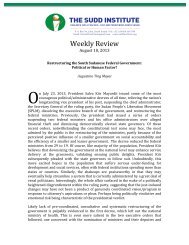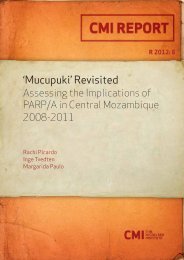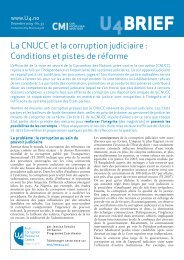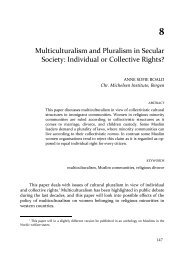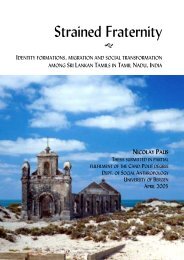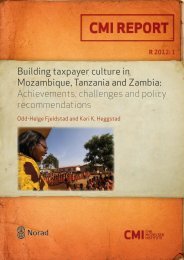Download (pdf) - CMI
Download (pdf) - CMI
Download (pdf) - CMI
You also want an ePaper? Increase the reach of your titles
YUMPU automatically turns print PDFs into web optimized ePapers that Google loves.
<strong>CMI</strong> REPORT DECENTRALISATION AND GENDER R 2008: 9<br />
5. Case four: Serengeti District Council<br />
By Christine Warioba, Bodil Maal and Betty Muze<br />
5.1 Socio-economic situation<br />
Serengeti District is one of the five districts constituting Mara Region. The district has an area of<br />
10, 373 sq.km. of which national parks/reserves occupy almost two thirds. 18 Only around 659<br />
sq.km is arable land used for human settlement, agricultural and livestock keeping activities. The<br />
main economic activity in the district is small scale agricultural production, where cultivation is<br />
mostly done by using ox-ploughs. There is limited production of cash crops such as cotton, coffee<br />
and to a very small extent tobacco. Other activities include livestock keeping, and to a small extent,<br />
small scale mining. The tourism industry mainly involves the Serengeti National Park, the Grumeti<br />
Fund (a so-called ‘VIP’ tourist facility), and Ikorongo Game Reserve.<br />
The district has critical shortage of staff and limited budget for health facilities and other<br />
institutions. The roads are in a bad state, especially during the rain seasons.<br />
According to the 2002 National Population and Housing Census, Serengeti district had a population<br />
of about 177,000 people. The largest ethnic group of the district is Kuria. Other groups include<br />
Ngoreme, Taturu, Ikoma, Nata, Isenye, Jita, and Sukuma. The district has a high number of<br />
Christian denominations, including Mennonites (USA), Lutherans, Anglicans, Seven Days<br />
Adventists, Roman Catholics, and Pentecostals. There are also some Muslims.<br />
Gender relations and community issues<br />
The Poverty and Human Development Report 2005 ranks Serengeti District as one of the poorest<br />
districts in Tanzania, with 61 % of the households living below the basic needs poverty line. The<br />
population is poor in terms of registered cash income, but the district has surplus in foodproduction,<br />
and the team did not get the impression that the district’s population was particularly<br />
poor.<br />
A large portion of Serengeti district became inhabited only 50 years ago. Informants say that due to<br />
this, the land is fertile, since it has not been exhausted. With good rains, the district normally<br />
produces excess food which is exported to other districts within the Mara region. Most of the<br />
households are also livestock keepers and cattle, goats, and sheep are sources of protein through<br />
milk as well as meat. Since the district borders to the Serengeti National Park, the people<br />
occasionally have access to game meat. Because of the above factors, the nutritional status of<br />
people in Serengeti district is quite good.<br />
Women in most households in the district own and have control over some cattle, milk and cash<br />
from the sales of milk, cattle and other agricultural produce. They are also involved in income<br />
generating activities and are able to control incomes from these activities. Women can own cattle<br />
from dowry paid for the marriages of their daughters (according to tradition, mothers do net get part<br />
of the dowry from the first daughter, but from the second and onwards).<br />
18 Serengeti National Park, 7000 sq. km., Ikorongo Game Reserve close to 190 sq.km, Grumeti Game Reserve around 66<br />
sq.km.<br />
29



